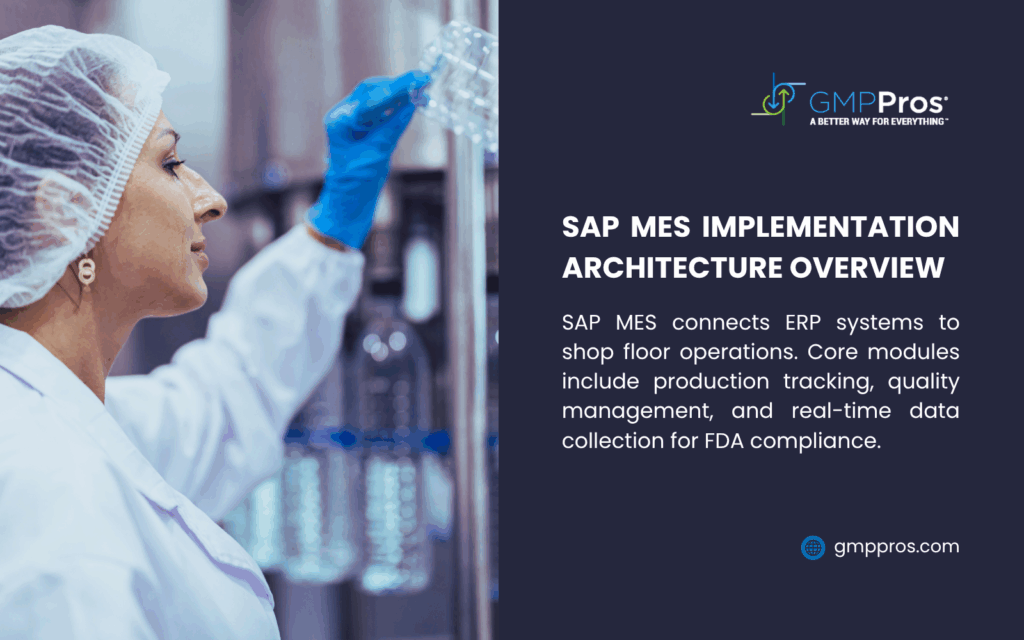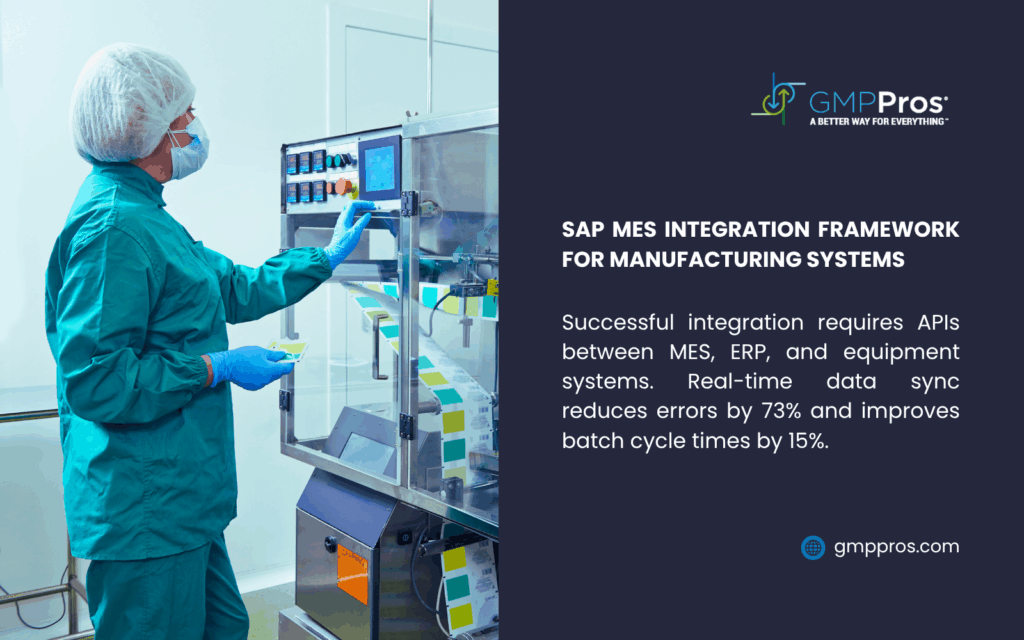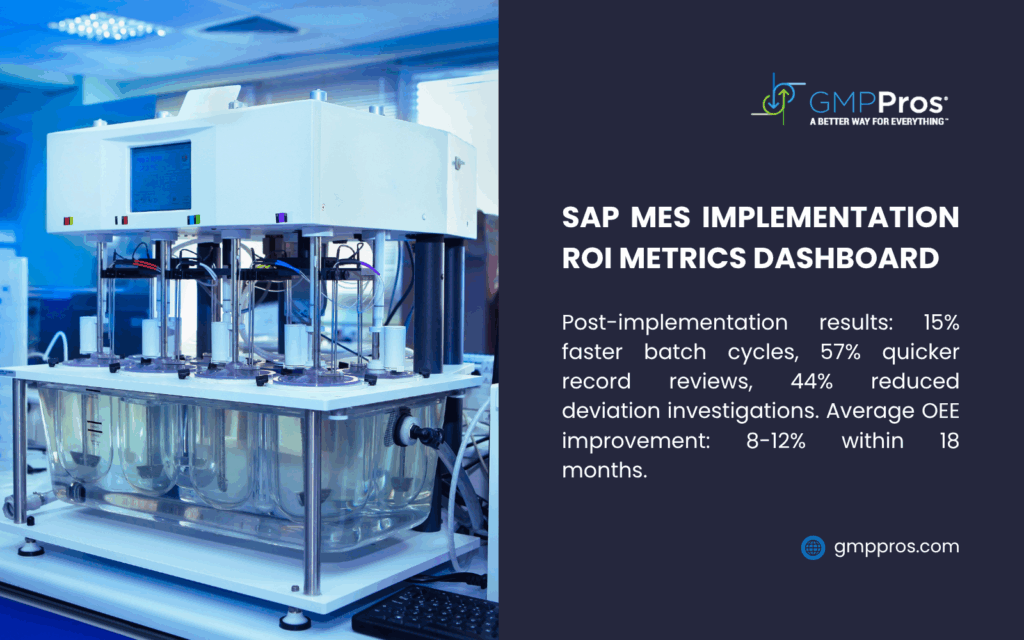Article Summary
This comprehensive guide explores SAP MES implementation in FDA-regulated manufacturing environments. Readers will learn about system architecture, project phases, regulatory compliance requirements, and best practices for successful deployment. The article covers technical specifications, validation protocols, and common challenges faced during implementation while providing actionable strategies for pharmaceutical, biologics, and food manufacturers.
Key Takeaways
- SAP MES implementation requires careful consideration of FDA regulatory requirements and GMP compliance
- Proper project planning and phased deployment approach reduces implementation risks by 40-60%
- Integration with existing ERP systems and batch record management is critical for operational success
- Validation documentation and change control procedures must align with 21 CFR Part 11 standards
- Post-implementation support and continuous improvement drive long-term ROI
What Is SAP MES Implementation?
SAP Manufacturing Execution System (MES) implementation refers to the systematic deployment of SAP’s manufacturing execution software to monitor, control, and optimize production processes in real-time. For FDA-regulated industries, sap mes implementation involves configuring the system to meet stringent regulatory requirements while maintaining operational efficiency.

The system serves as a bridge between enterprise resource planning (ERP) systems and shop floor operations, providing manufacturers with complete visibility into production activities. SAP MES captures data from manufacturing equipment, tracks material consumption, monitors quality parameters, and generates comprehensive production reports required for regulatory compliance.
Core Components of SAP MES Architecture
| Component | Function | Regulatory Impact |
| Production Tracking | Monitor batch progress and material flow | Supports FDA audit trail requirements |
| Quality Management | Control in-process testing and specifications | Ensures GMP compliance documentation |
| Resource Management | Manage equipment, personnel, and materials | Facilitates change control procedures |
| Data Collection | Capture real-time manufacturing data | Enables 21 CFR Part 11 electronic records |
| Reporting Engine | Generate batch records and compliance reports | Provides regulatory submission documentation |
Pre-Implementation Assessment Framework
Before initiating sap mes implementation, manufacturers must conduct thorough assessments of current state operations and future requirements. This evaluation forms the foundation for successful system deployment.
Current State Analysis
Manufacturing organizations need to document existing processes, systems, and data flows. The assessment should identify gaps between current capabilities and regulatory requirements, particularly in areas of data quality monitoring and pharma compliance.
Legacy systems often lack proper electronic signature capabilities, audit trail functionality, or integration with quality management systems. These deficiencies must be addressed during the SAP MES configuration phase.
Regulatory Requirements Mapping
| Regulation | Requirement | SAP MES Feature |
| 21 CFR Part 11 | Electronic signatures | Digital signature module |
| ICH Q10 | Quality risk management | Risk assessment workflows |
| FDA Process Validation | Statistical process control | Real-time SPC monitoring |
| EU GMP Annex 11 | Computerized system validation | Validation management tools |
| ISPE GAMP 5 | Software lifecycle | Change control system |
SAP MES Implementation Project Plan Structure
A well-structured mes implementation project plan typically spans 12-18 months for complex manufacturing environments. The phased approach allows for controlled deployment while minimizing operational disruption.
Phase 1: Foundation Setup (Months 1-4)
The initial phase focuses on system installation, basic configuration, and infrastructure preparation. Technical teams establish development, test, and production environments while configuring core system parameters.
Critical activities include database setup, user account creation, and basic workflow configuration. Security protocols must be established early to support pharma regulatory compliance requirements.
Phase 2: Process Configuration (Months 5-10)
During this phase, business processes are configured within the SAP MES framework. Manufacturing recipes, quality specifications, and routing definitions are created to match current production requirements.
Electronic batch record templates are developed and tested to ensure compliance with FDA expectations. Integration points with existing ERP systems and laboratory information management systems (LIMS) are established.
Phase 3: Validation and Testing (Months 11-14)
Comprehensive system validation follows GAMP 5 guidelines and includes installation qualification (IQ), operational qualification (OQ), and performance qualification (PQ). Test scenarios cover normal operations, exception handling, and disaster recovery procedures.
User acceptance testing involves production personnel who will operate the system daily. Their feedback helps refine workflows and identify potential training gaps before go-live.
Phase 4: Deployment and Support (Months 15-18)
Production cutover occurs in phases, typically by manufacturing line or product family. Parallel operations may run for several weeks to ensure system stability and data accuracy.
Post-implementation support includes performance monitoring, user training, and continuous improvement activities. Organizations often see 15-25% improvements in manufacturing efficiency within the first year after deployment.

Integration Challenges and Solutions
Successful sap mes implementation requires seamless integration with existing manufacturing systems and enterprise applications. Common integration points include ERP systems, laboratory equipment, process historians, and quality management platforms.
ERP System Integration
| Integration Area | Challenge | Solution Approach |
| Material Master Data | Data synchronization delays | Real-time integration APIs |
| Production Orders | Order status discrepancies | Automated status updates |
| Inventory Management | Stock level inconsistencies | Bi-directional data flow |
| Cost Accounting | Manufacturing cost allocation | Automated cost posting |
SAP MES must maintain data consistency with ERP systems while providing real-time manufacturing visibility. This requires careful design of integration interfaces and error handling procedures.
Equipment Integration
Manufacturing equipment integration presents unique challenges in FDA-regulated environments. Equipment qualification status, calibration records, and maintenance schedules must be synchronized between SAP MES and computerized maintenance management systems (CMMS).
Data integrity protocols ensure that equipment-generated data meets regulatory standards for accuracy, completeness, and reliability. Automated data collection reduces manual transcription errors while maintaining data quality standards.
Regulatory Compliance Considerations
FDA-regulated manufacturers face specific requirements during sap mes implementation that non-regulated industries may not encounter. These requirements affect system design, validation approaches, and ongoing maintenance procedures.
21 CFR Part 11 Compliance
Electronic records and signatures functionality must be properly configured and validated. This includes user authentication protocols, audit trail generation, and record retention policies.
System administrators must establish appropriate user roles and access controls to prevent unauthorized changes to batch manufacturing records. Regular access reviews help maintain compliance with security requirements.
Change Control Integration
SAP MES changes must follow established change control procedures to maintain system validation status. Minor configuration changes may require impact assessments while major modifications could trigger revalidation activities.
Documentation requirements include change requests, impact assessments, test results, and approval records. These documents support regulatory inspections and demonstrate controlled system maintenance.
Performance Optimization Strategies
Post-implementation optimization focuses on maximizing system performance and user adoption. Key areas include database tuning, workflow optimization, and report generation efficiency.
Database Performance Tuning
| Optimization Area | Technique | Expected Improvement |
| Query Response Time | Index optimization | 30-50% faster queries |
| Data Archiving | Historical data management | 25% database size reduction |
| Backup Procedures | Incremental backup strategy | 60% faster backup completion |
| Report Generation | Cached report templates | 40% faster report delivery |
Regular performance monitoring identifies bottlenecks before they impact production operations. Proactive maintenance prevents system slowdowns that could affect manufacturing process improvement initiatives.

User Experience Enhancement
Training programs and user support systems contribute significantly to implementation success. Regular feedback sessions help identify workflow improvements and additional training needs.
Mobile device support allows production supervisors to access SAP MES functionality from the manufacturing floor, improving response times to production issues and quality deviations.
Common Implementation Pitfalls
Many sap mes implementation projects encounter similar challenges that can be avoided with proper planning and execution strategies.
Scope Creep Management
Organizations often attempt to address all manufacturing challenges within the initial SAP MES implementation scope. This approach typically leads to extended timelines, budget overruns, and reduced system stability.
Successful implementations focus on core MES functionality first, then expand capabilities through planned enhancement projects. This phased approach allows users to adapt to new processes gradually while maintaining production schedules.
Data Migration Complexity
Historical manufacturing data migration requires careful planning and validation. Legacy data quality issues often surface during migration activities, requiring cleanup efforts that can delay project timelines.
Data mapping exercises should begin early in the project lifecycle to identify and address quality issues. Automated data validation tools help detect inconsistencies before they impact production operations.
ROI Measurement and Success Metrics
Successful sap mes implementation delivers measurable improvements in operational efficiency, regulatory compliance, and manufacturing costs. Organizations typically track key performance indicators (KPIs) to demonstrate project value.
Operational Efficiency Metrics
| Metric | Baseline | Post-Implementation | Improvement |
| Batch Cycle Time | 8.5 hours | 7.2 hours | 15% reduction |
| Data Collection Time | 45 minutes | 12 minutes | 73% reduction |
| Deviation Investigation | 3.2 days | 1.8 days | 44% reduction |
| Batch Record Review | 2.1 days | 0.9 days | 57% reduction |
These improvements contribute to increased manufacturing capacity and reduced production costs. Organizations often report 8-12% increases in overall equipment effectiveness (OEE) within 18 months of implementation.
Compliance Benefits
SAP MES implementation reduces regulatory compliance risks through improved data integrity, automated audit trails, and standardized procedures. Inspection readiness improves significantly as electronic batch records provide complete production documentation.
Regulatory citation reductions of 30-40% are common following successful MES implementation. This improvement reflects better process control, data quality, and documentation practices.
Vendor Selection and Partnership Considerations
Selecting the right implementation partner significantly impacts project success. Organizations should evaluate potential partners based on regulatory experience, technical capabilities, and industry knowledge.
GMP Pros specializes in MES implementation for pharmaceutical manufacturers, providing deep regulatory expertise combined with hands-on technical capabilities. Their team embeds within client organizations to drive change from within while maintaining focus on compliance requirements.
Implementation partners should demonstrate experience with similar regulatory environments and proven track records in SAP MES deployments. Reference checks with previous clients provide valuable insights into partner capabilities and project management approaches.
Future Technology Integration
Modern SAP MES implementations increasingly incorporate emerging technologies such as artificial intelligence, machine learning, and industrial IoT devices. These capabilities enhance traditional MES functionality while providing new opportunities for process improvement.
Digital Transformation Opportunities
Integration with advanced analytics platforms enables predictive maintenance, quality prediction, and process optimization. These capabilities build upon core SAP MES functionality to deliver additional business value.
Cloud deployment options provide scalability and reduced infrastructure costs while maintaining regulatory compliance requirements. Hybrid architectures allow organizations to balance cost optimization with security requirements.

Conclusion
SAP MES implementation in FDA-regulated manufacturing environments requires careful planning, regulatory expertise, and phased deployment approaches. Success depends on proper system configuration, thorough validation, and ongoing optimization efforts.
Organizations that invest in comprehensive implementation planning and select experienced partners typically achieve significant improvements in operational efficiency, regulatory compliance, and manufacturing costs. The key lies in balancing technical capabilities with regulatory requirements while maintaining focus on user adoption and business value delivery.
For manufacturers considering SAP MES implementation, partnering with specialists who understand both technical requirements and regulatory compliance is essential. GMP Pros offers comprehensive electronic batch record implementation services that ensure successful system deployment while maintaining FDA compliance standards.Ready to explore how SAP MES implementation can transform your manufacturing operations? Contact our team to discuss your specific requirements and develop a customized implementation strategy.

